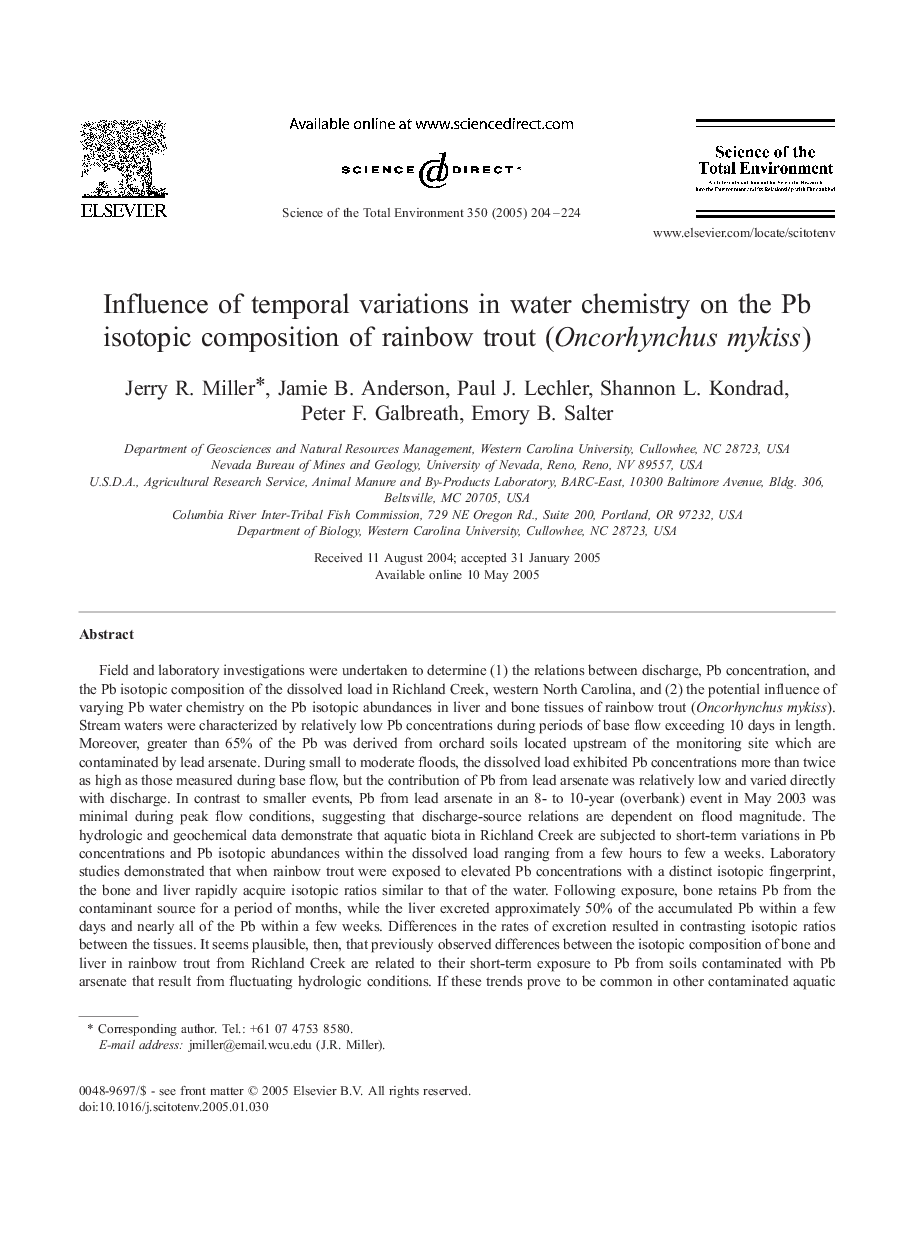| کد مقاله | کد نشریه | سال انتشار | مقاله انگلیسی | نسخه تمام متن |
|---|---|---|---|---|
| 10110602 | 1619988 | 2005 | 21 صفحه PDF | دانلود رایگان |
عنوان انگلیسی مقاله ISI
Influence of temporal variations in water chemistry on the Pb isotopic composition of rainbow trout (Oncorhynchus mykiss)
دانلود مقاله + سفارش ترجمه
دانلود مقاله ISI انگلیسی
رایگان برای ایرانیان
کلمات کلیدی
موضوعات مرتبط
علوم زیستی و بیوفناوری
علوم محیط زیست
شیمی زیست محیطی
پیش نمایش صفحه اول مقاله

چکیده انگلیسی
Field and laboratory investigations were undertaken to determine (1) the relations between discharge, Pb concentration, and the Pb isotopic composition of the dissolved load in Richland Creek, western North Carolina, and (2) the potential influence of varying Pb water chemistry on the Pb isotopic abundances in liver and bone tissues of rainbow trout (Oncorhynchus mykiss). Stream waters were characterized by relatively low Pb concentrations during periods of base flow exceeding 10 days in length. Moreover, greater than 65% of the Pb was derived from orchard soils located upstream of the monitoring site which are contaminated by lead arsenate. During small to moderate floods, the dissolved load exhibited Pb concentrations more than twice as high as those measured during base flow, but the contribution of Pb from lead arsenate was relatively low and varied directly with discharge. In contrast to smaller events, Pb from lead arsenate in an 8- to 10-year (overbank) event in May 2003 was minimal during peak flow conditions, suggesting that discharge-source relations are dependent on flood magnitude. The hydrologic and geochemical data demonstrate that aquatic biota in Richland Creek are subjected to short-term variations in Pb concentrations and Pb isotopic abundances within the dissolved load ranging from a few hours to few a weeks. Laboratory studies demonstrated that when rainbow trout were exposed to elevated Pb concentrations with a distinct isotopic fingerprint, the bone and liver rapidly acquire isotopic ratios similar to that of the water. Following exposure, bone retains Pb from the contaminant source for a period of months, while the liver excreted approximately 50% of the accumulated Pb within a few days and nearly all of the Pb within a few weeks. Differences in the rates of excretion resulted in contrasting isotopic ratios between the tissues. It seems plausible, then, that previously observed differences between the isotopic composition of bone and liver in rainbow trout from Richland Creek are related to their short-term exposure to Pb from soils contaminated with Pb arsenate that result from fluctuating hydrologic conditions. If these trends prove to be common in other contaminated aquatic environments, it may be possible to use the Pb isotopic composition of bone as an indicator of the long-term exposure to Pb and the liver as a biomarker for short-term Pb exposures.
ناشر
Database: Elsevier - ScienceDirect (ساینس دایرکت)
Journal: Science of The Total Environment - Volume 350, Issues 1â3, 1 November 2005, Pages 204-224
Journal: Science of The Total Environment - Volume 350, Issues 1â3, 1 November 2005, Pages 204-224
نویسندگان
Jerry R. Miller, Jamie B. Anderson, Paul J. Lechler, Shannon L. Kondrad, Peter F. Galbreath, Emory B. Salter,